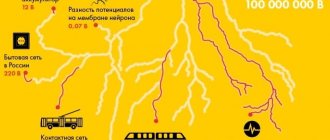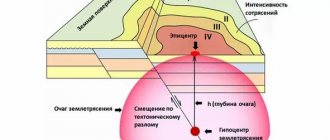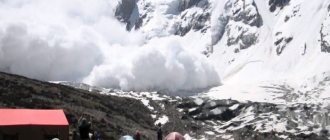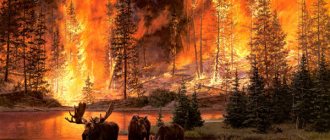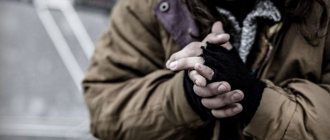EARTHQUAKE – A TERRIBLE NATURAL PHENOMENON
An earthquake is a powerful destructive natural disaster, the effect of which occurs suddenly and occurs instantly.
An earthquake is an underground tremors and vibrations of the earth's surface that arise as a result of sudden displacements and ruptures in the earth's crust or in the upper part of the mantle and are transmitted over long distances in the form of elastic vibrations.
During earthquakes, people die, houses, roads, bridges, canals, dams and other engineering structures, water pipelines, pipelines, sewers, power lines are destroyed, communications are disrupted, avalanches, rockfalls, mudflows, collapses and landslides, cracks in rocks occur, people are seized by panic. During underwater and coastal earthquakes, as a result of seabed shifts, sea gravitational waves - tsunamis - occur, which cause devastating destruction on land.
Seismically hazardous zones in Russia
Despite the fact that our country is classified as moderately dangerous in terms of the occurrence of strong earthquakes, 1/3 of its territory is included in the zone of seismic activity (110 cities).
On the island of Sakhalin (Neftegorsk), on May 28, 1995, the most destructive earthquake in the entire history of Russia occurred.
Most of the houses were destroyed because their construction did not meet safety standards for such earthquake-prone regions. The population of the city at that time was about 3,000 people.
2040 people were victims of the tragedy.
Today, the entire territory of the Far East, including Sakhalin Island and the Kuril-Kamchatka region, belongs to earthquake-prone areas. The Kamchatka Peninsula is part of the so-called Pacific belt, which accounts for 2/3 of the world's largest earthquakes. According to scientists, catastrophic earthquakes are possible here in the next 10 years.
This is interesting: Spawning ban 2020 KIROV REGION
2. Regions of the North Caucasus
Until the 20th century, many lands of the Caucasus, especially in mountainous areas, were not developed, they were not studied for seismic activity, and therefore earthquakes were not recorded there. In 2008, an earthquake of 6 magnitude occurred on the territory of the Chechen Republic, as a result of which 13 people died.
Since most of the cities in this region are located in mountainous areas, seismologists predict the occurrence of catastrophic earthquakes here.
The territory of Crimea has been known as earthquake-prone since the 5th century. BC e. We see the consequences of powerful earthquakes in the past today in the form of mud volcanoes.
The famous Kara-Dag mountain is the result of a powerful volcanic eruption during an earthquake. Many earthquakes in Crimea can lead to a tsunami, since their sources will lie on the seabed.
So, in the last century (1927), during a strong earthquake in Crimea, residents already observed very high waves on the Black Sea. By the way, it was this earthquake that served as the beginning of the creation in Russia of the first standards for the construction of buildings in earthquake-prone regions.
4. South of Siberia, Altai, Sayan Mountains, Baikal and Transbaikalia
The territory of Altai is classified as earthquake-prone, as strong earthquakes occur here once every 10 years. The most destructive tremors of 7.3 occurred in 2003.
5. The regions of central Russia also cannot feel completely safe, although scientists do not classify them as seismically dangerous.
For example, in Moscow, a strong earthquake was recorded in the chronicles in 1445, as a result of which the central part of the city around the Kremlin shook. Today, seismologists have calculated that in the next 50 years, earthquakes of about 5 magnitude are possible in Moscow with a 10% probability.
GENERAL TIPS
In order to increase your chances of staying alive and protecting yourself from injury during an earthquake, every person in a building or structure must determine in advance a relatively safe place where they can wait out the tremors, and after they are over, quickly leave the room.
Practice has proven that relatively safe places are openings of main internal walls, corners formed by internal main walls, places near internal main walls, near columns and under frame beams, entrance door openings, durable tables, workbenches, etc.
During the Spitak earthquake, which occurred on December 7, 1988, six people who were in the bathrooms remained alive.
The most dangerous places in buildings during an earthquake are large glazed openings of external and internal walls, corner rooms, especially on the top floors, elevators, landings and flights, and balconies.
Try to think in advance about how you need to act in case of an earthquake in various conditions: at home, at work, on the street and in other places. The action plan at home and at work should be especially detailed.
First of all, you need to proceed from the degree of seismic resistance of the buildings in which you live or work.
Taking into account the strength of your building, the place where you are within the building, and the time reserve of only 15-20 seconds, you can decide in advance what is reasonable for you to behave during a strong earthquake: either try to quickly leave the building, or occupy a relatively safe place.
Having a plan in advance will help you act more quickly and intelligently. But be prepared to also change it depending on the circumstances.
After shocks and strong swaying of the building you are inside, destruction may begin, and individual floor slabs or blocks of main walls may fall. In this case, trying to leave that building during an earthquake may be less risky than staying inside the building. Please note that neither the destruction of partitions (non-permanent walls) nor the fall of curtain wall panels of frame buildings indicate that the building is imminently about to collapse.

Actions when blocked by debris
Finding yourself in a rubble, you must by any means wait for help, which will definitely arrive. Wiggle your toes, try to move, this will help you assess your own injuries (if any) and determine the availability of free space. Don't use too much oxygen. Breathe evenly. If you have a working flashlight, look around. You may see pipes that you can knock on and thereby attract attention. Also finding beams, use them to reinforce the ceiling or overhanging debris.
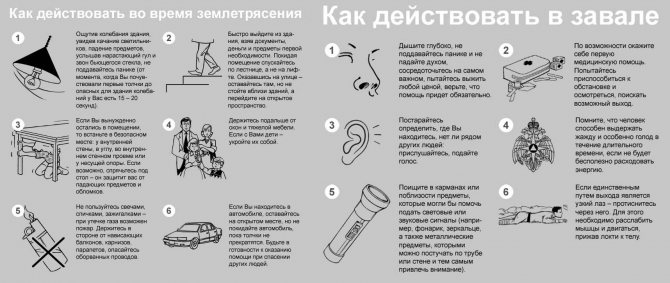
How to act in a collapse
The use of matches and lighters is prohibited. If possible, roll over onto your stomach to relieve pressure on your chest. Rub your limbs from time to time. This will help restore blood circulation and keep you warm. You can read more about what to do in case of building collapse.
What to do BEFORE an earthquake?
Create a family earthquake plan that includes:
- information on telephone numbers and addresses of emergency medical care, fire and emergency services, apartment owners' cooperative (AOC), civil protection;
- general information about family and loved ones;
- medical information about family and loved ones;
- names, addresses, telephone numbers of closest friends, relatives, contact persons who can help both inside the disaster zone and outside it;
- plan for coordination and interaction within the family and with neighbors, incl. every family member (especially children) should know where they should go if they cannot return home;
- who, where and how should turn off electricity, water, gas;
- how will you manage without the engineering support of your home - without water, electricity, gas, sewerage for at least 2-3 weeks;
- if your family has children, old people, disabled or seriously ill people, especially think about their life support;
- If you have pets, don't forget about food and water for them.
Coordinate your family plan with the collection and evacuation plan for your children at daycare and school, as well as with the emergency plans of other family members at work. In addition, you must know exactly: how long your children will be protected at school until their parents arrive, where to pick up their children from if the school is damaged, where the children will be if parents cannot come.
Don't forget to give a copy of the most important parts of the family plan to your children's school teacher or kindergarten teacher; write down your blood type and Rh factor in your passport or other document; Write down in the plan chronic illnesses of family members and health problems, as well as corresponding prohibitions, restrictions, necessary medications, especially those without which you cannot live.
Firmly attach cabinets, shelves, racks, and shelves to the walls and floor. Don't place beds near windows. Do not place shelves above beds, doors, or stoves. Place furniture so that it cannot block exits from rooms or block doors.
Do not block corridors, passages, staircases, doorways with furniture and property.
Learn to turn off electricity, gas and water supply in the apartment or the entrance of the house.
Have at home a supply of canned food and water, a bucket of sand, a portable electric flashlight, a fire extinguisher (car), and a first aid kit. Learn first aid techniques.
Store hazardous substances (toxic chemicals, flammable liquids) in a safe place where they cannot break or spill.
Keep documents in a designated place. Store a backpack with spare clothes, shoes (according to the season), a flashlight, a hatchet, a first aid kit, candles, personal hygiene items, a transistor radio, spoons, knives, matches, and food at the exit from the apartment.
To protect your home in the event of damage, have several sheets of plywood and heavy-duty plastic ready to cover broken windows and other holes.
Agree with your neighbors on mutual assistance and joint actions in case of emergencies.
Know the assembly point and evacuation procedures.
A garage or cottage can be used as a temporary shelter in the first days after a strong earthquake. Keep food supplies and spare items there.
As a family, periodically conduct conversations and training in case of an earthquake.
How to escape in case of an earthquake
Today there are many official recommendations in case of an earthquake. However, many years of experience show that during very strong earthquakes such recommendations are sometimes not useful, but rather the opposite. Thus, during the earthquake that occurred in Armenia in 1988, many victims were among schoolchildren who took refuge under their desks - just as they were taught. Only a few survived, jumping out of the windows, contrary to recommendations. Even then they started saying that the common practice of taking shelter under a table or bed, as well as in a doorway during an earthquake, was wrong. Today there is plenty of evidence of this. American rescuer, recognized UN expert on saving human life, Douglas Kopp, developed his theory of earthquake survival. He was one of those who single-handedly rescued people from the Twin Towers in America on September 11th. Today, Douglas is the founder and leader of the international rescue team AmericanRescueTeam.
During his work, Douglas participated in the elimination of the most destructive earthquakes in 60 countries. Based on his observations, he compiled rules of behavior in the event of severe destruction, which increase a person’s chances of survival.
When there is a threat of an earthquake
In the event of a threat of an earthquake, electric sirens, production horns and other means of warning will be turned on, which means the warning signal “Attention everyone!” At this signal, you need to turn on the radio and television receivers, listen carefully to the message about the emergency situation and strictly follow the instructions of local authorities and emergency management authorities.
If you are at home:
– check the fire extinguisher, fill the bathtub and buckets with water;
– change into clothes and shoes that can protect you;
– turn off the gas, water and electricity in the apartment, turn off the stove;
– take with you a pre-prepared bag, a backpack with things, documents, notify your neighbors, provide assistance to lonely, sick people, leave the building, go to the designated collection point, wait for further instructions;
– return to normal activities should be carried out according to the instructions of local authorities or emergency management authorities.
If you are in public places:
- behave calmly, do not create panic, do not rush to the exit and do not create traffic jams in the way of people, help the sick and disabled;
– follow the instructions of the administration.
DURING an earthquake:
– At the first shock, residents of the 1st floor need to quickly, but without panic, leave the building, and those living above need to take relatively safe places, covering their heads with their hands.
– As soon as the shaking subsides, immediately leave the building via the stairs, pressing your back against the wall. Try to turn off the gas, water, electricity, take with you documents, money, a backpack with things, a first aid kit, lock the door.
– If there are children and elderly people in neighboring apartments, help them get out into the street, there provide first aid to the victims.
– Move to an open place away from buildings and power lines. Proceed to the designated collection point. Beware of broken wires; keep children away from them.
– While driving, stop in an open place and do not get out of the car until the shaking stops. In public transport, remain in your seats, asking the driver to open the doors; after shocks, calmly, without crowding, leave the cabin.


